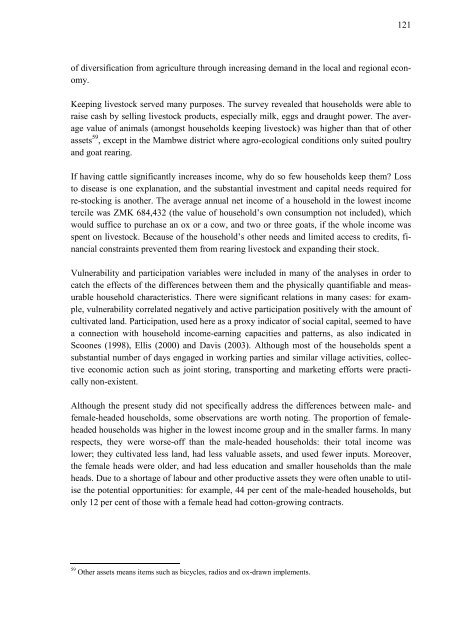Rural Income Generation and Diversification - A Case Study ... - Doria
Rural Income Generation and Diversification - A Case Study ... - Doria
Rural Income Generation and Diversification - A Case Study ... - Doria
You also want an ePaper? Increase the reach of your titles
YUMPU automatically turns print PDFs into web optimized ePapers that Google loves.
of diversification from agriculture through increasing dem<strong>and</strong> in the local <strong>and</strong> regional economy.<br />
Keeping livestock served many purposes. The survey revealed that households were able to<br />
raise cash by selling livestock products, especially milk, eggs <strong>and</strong> draught power. The average<br />
value of animals (amongst households keeping livestock) was higher than that of other<br />
assets 59 , except in the Mambwe district where agro-ecological conditions only suited poultry<br />
<strong>and</strong> goat rearing.<br />
If having cattle significantly increases income, why do so few households keep them? Loss<br />
to disease is one explanation, <strong>and</strong> the substantial investment <strong>and</strong> capital needs required for<br />
re-stocking is another. The average annual net income of a household in the lowest income<br />
tercile was ZMK 684,432 (the value of household’s own consumption not included), which<br />
would suffice to purchase an ox or a cow, <strong>and</strong> two or three goats, if the whole income was<br />
spent on livestock. Because of the household’s other needs <strong>and</strong> limited access to credits, financial<br />
constraints prevented them from rearing livestock <strong>and</strong> exp<strong>and</strong>ing their stock.<br />
Vulnerability <strong>and</strong> participation variables were included in many of the analyses in order to<br />
catch the effects of the differences between them <strong>and</strong> the physically quantifiable <strong>and</strong> measurable<br />
household characteristics. There were significant relations in many cases: for example,<br />
vulnerability correlated negatively <strong>and</strong> active participation positively with the amount of<br />
cultivated l<strong>and</strong>. Participation, used here as a proxy indicator of social capital, seemed to have<br />
a connection with household income-earning capacities <strong>and</strong> patterns, as also indicated in<br />
Scoones (1998), Ellis (2000) <strong>and</strong> Davis (2003). Although most of the households spent a<br />
substantial number of days engaged in working parties <strong>and</strong> similar village activities, collective<br />
economic action such as joint storing, transporting <strong>and</strong> marketing efforts were practically<br />
non-existent.<br />
Although the present study did not specifically address the differences between male- <strong>and</strong><br />
female-headed households, some observations are worth noting. The proportion of femaleheaded<br />
households was higher in the lowest income group <strong>and</strong> in the smaller farms. In many<br />
respects, they were worse-off than the male-headed households: their total income was<br />
lower; they cultivated less l<strong>and</strong>, had less valuable assets, <strong>and</strong> used fewer inputs. Moreover,<br />
the female heads were older, <strong>and</strong> had less education <strong>and</strong> smaller households than the male<br />
heads. Due to a shortage of labour <strong>and</strong> other productive assets they were often unable to utilise<br />
the potential opportunities: for example, 44 per cent of the male-headed households, but<br />
only 12 per cent of those with a female head had cotton-growing contracts.<br />
59 Other assets means items such as bicycles, radios <strong>and</strong> ox-drawn implements.<br />
121

















